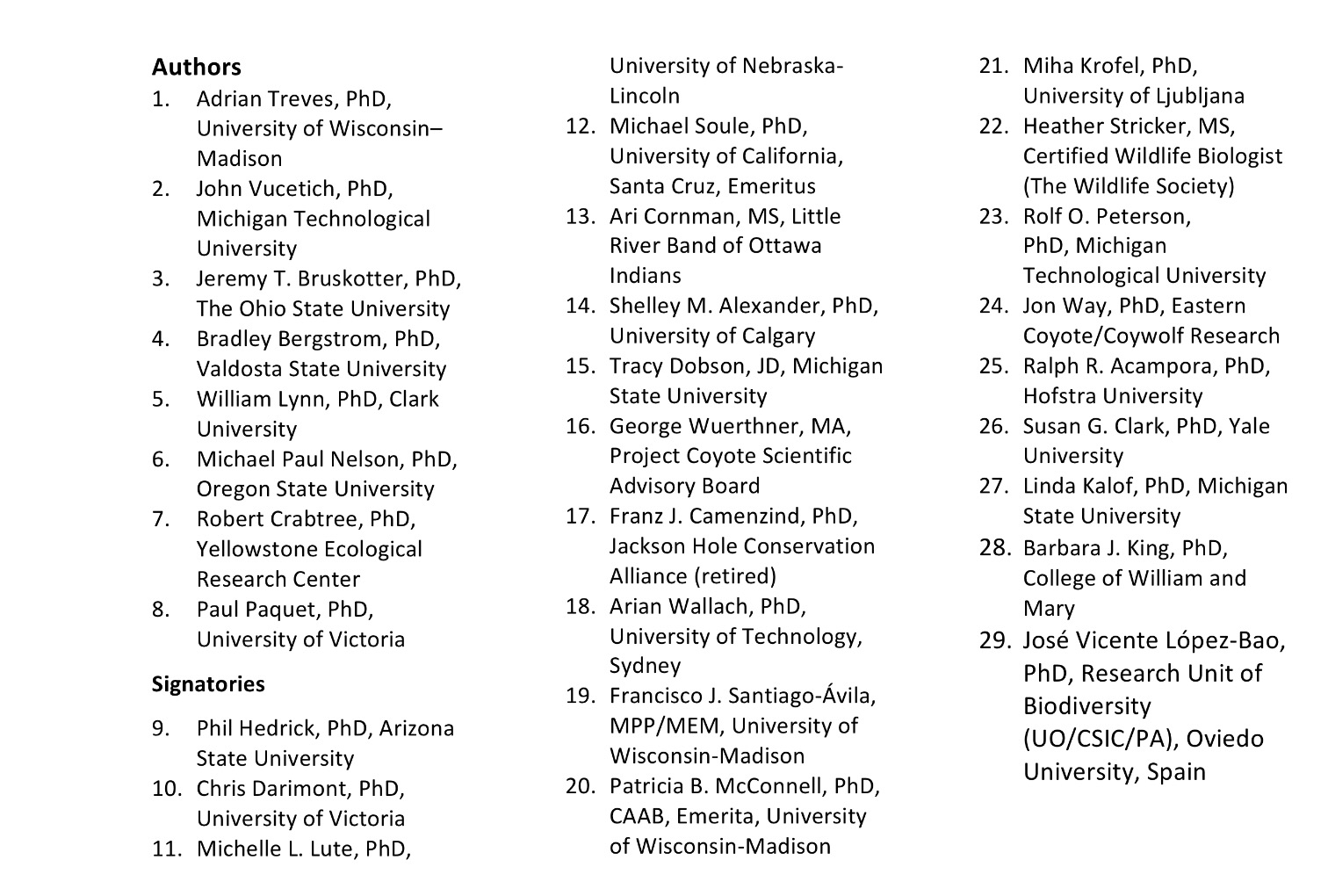However, in a letter sent yesterday, 29 scientists counter the previous letter and are against the delisting of these same wolves. This is their letter:
23 November 2015
Dear trustees of the public interest,
The under-signed scientists and scholars address some of the public policy questions surrounding wolf conservation under the Endangered Species Act (ESA). Another group of scientists recently (11/18/15) publicized a letter, concluding that wolves in the Great Lakes region ought to be delisted. That letter, which we refer to as Mech et al., is based on a misunderstanding of three points of law and scientific evidence: (1) public attitudes about wolves and the ESA, (2) adequacy of management by the states, and (3) legal requirements of the ESA. We explain the misunderstandings with evidence to support each of our claims. We conclude wolves should still be protected under the ESA.
1. The science of public attitudes
Data indicate that the vast majority of the U.S. public holds positive attitudes toward wolves and support the ESA 1. Contrary to the assertions of Mech et al., existing evidence does not support the claim that keeping wolves on the ESA “creates public resentments towards the species and the ESA”. This claim is asserted without any supporting evidence, and runs exactly contrary to the scientific evidence. Long-term data suggest that removal of ESA protections led to lower tolerance for wolves in Wisconsin 2. The best available science also indicates that the general public is more tolerant of wolves than is commonly assumed. Indeed, recent polling data confirm that there is strong support for both wolves and the ESA nationally. Indeed support for wolves has actually increased substantially over the past three and a half decades 1. Views to the contrary are fueled primarily by special interest groups that are vocal, but small in number. Mech et al. further imply, and the U.S. Fish and Wildlife Service (FWS) has said 3, that social intolerance prevents wolves, at this time, from occupying more habitat than they currently occupy. Bruskotter and colleagues offer important evidence to the contrary 4. More likely, a significant threat to recovery in recent years is legal killing that is implemented by the states and sanctioned by the FWS. No less important, the purpose of the ESA is to mitigate threats to recovery. Consequently, insomuch as wolves are not legally recovered (see next section of this letter), then a great threat to achieving recovery is current lethal management, not intolerance by citizens.
2. The science surrounding the adequacy of state management
A 2011 Presidential Order mandated, ”Our regulatory system…must be based on the best available science.“ 5 . The ESA requires adequacy of existing regulatory mechanisms before delisting an endangered species (Sec. 4(a)(1)(D)).
Mech et al. assert, “adequate regulatory mechanisms for wolf management are in place in the western Great Lakes states”, without providing supporting evidence. Their statement also ignores substantial criticisms of state regulation. There are two scientific concerns about the adequacy of state regulatory mechanisms to protect wolves. First, several teams of scientists have questioned the sustainability and science behind existing wolf-hunting plans 6, 7, 8. Second, the methods Wisconsin used to count wolves have been questioned on scientific grounds of accuracy and bias 9. Adding to scientific concerns, the federal court questioned the existing regulatory mechanisms in Minnesota and states in the region without wolf management plans 10. That court found “virtually no controls exist under the Minnesota plan on the killing of wolves in two-thirds of the state…” (p. 106). Taken together, the scientific evidence and the legal requirements both point to inadequacy of existing regulatory mechanisms to ensure the persistence of wolves in the region.
3. Legal requirements of the Endangered Species Act
Mech et al. argue that delisting has become “nearly impossible” due to “litigation typically based on legal technicalities rather than biology.” Their view is a profound misrepresentation. The FWS attempted and failed to delist wolves, not because of legal technicalities, but because the biological status and management of wolves do not meet standards required by the ESA. One of the most important gaps pertains to the inadequacy of existing regulatory mechanisms (see previous section of this letter). A second fundamental gap is the legal definition of endangerment (ESA Sec. 4(a)(1)). Quite simply, wolves still fit the legal definition of endangerment in the Great Lakes region and nationwide. These views are supported by published evidence, repeated judicial opinion, and congressional intent, as explained in numerous peer-reviewed articles 11.
Mech et al. advocate for Congress to sidestep the ESA and the current federal Court of Appeals (their footnote 2). We disagree because such action does not serve the broad public interest in safeguarding public trust assets, such as wolves.
For the above reasons, wolves in the Great Lakes region should remain protected under the ESA at this time and until the legal requirements for delisting are met. Delisting is possible, if and when the FWS uses the best available science that justifies delisting. Currently it does not.

Source
_________________________________________________
source



No comments:
Post a Comment